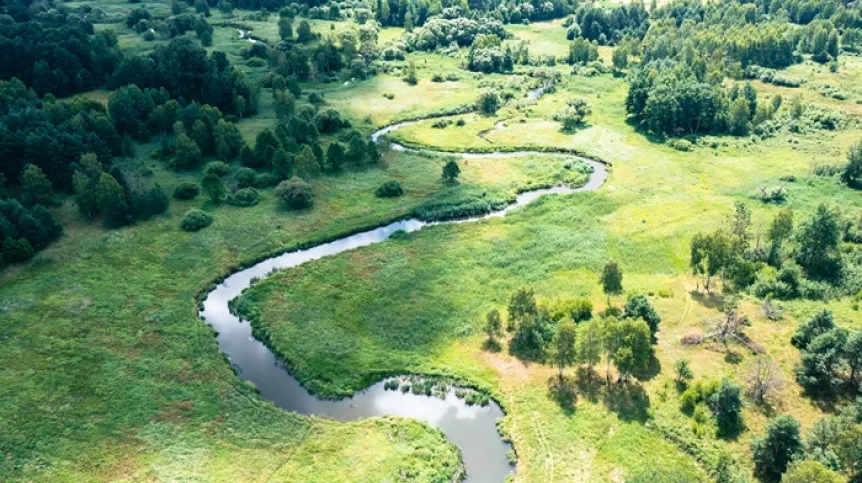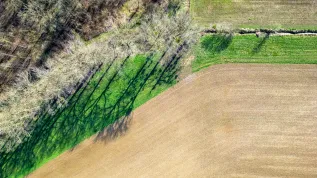
Despite the huge progress that has been made over several decades, the situation of Polish surface waters is rather bad, although it is no different from Western Europe in this respect. A lot can be changed with simple methods, says Dr. Paweł Jarosiewicz, an ecohydrologist from the University of Lodz.
The researcher, who is working on biological wastewater treatment plants, told PAP that the condition of Poland's surface waters is 'very unsatisfactory'.
He said: ‘For example, over 90% of Polish rivers are in a poor condition according to the Water Framework Directive. The basic pollutants are nitrogen and phosphorus. These are biogenic substances that cause eutrophication, i.e. overfertilisation of the aquatic environment. In fact, every summer we observe the effects of this in the form of algae development and cyanobacterial blooms. This is when we usually start talking about pollutants, but they flow into water all year round. These substances come from dispersed sources, such as agricultural fields and stormwater runoff in cities, as well as single point sources such as sewage treatment plants.’
Because scientists only take into account a small part of the pollutants that may appear in water, many substances have not yet been tested at all. Various types of xenobiotics, i.e. substances foreign to the environment produced by the modern chemical industry, enter the water.
'These include pesticides and pharmaceuticals. There are more and more of these compounds, because new ones are being developed all the time. We currently monitor water for the presence of about 40 compounds, and there may be 20 times more of them. Unfortunately, even well-functioning treatment plants cannot remove all of them,’ Jarosiewicz said.
In his opinion, in terms of water quality, the situation of Poland is similar to Western countries.
'The quality of water largely depends on the part of the continent. For example, in Denmark, where the sources of pollution are intensive agriculture and animal breeding, waters are heavily polluted with nitrogen compounds; phosphorus dominates in other regions, in others still - pesticides. In countries with large forest cover, the share of pollution in rivers is smaller, but in most of Europe, 60-70 percent of the area is agriculture, urbanized areas and scattered buildings, where the greatest pressure on water resources is generated,’ said Jarosiewicz
He added that there has been a huge improvement in the last 2-3 decades. Legal regulations have enabled Poland to significantly reduce pollution from sewage, in part through programs for the construction of sewage treatment plants.
Jarosiewicz continued: ‘However, by analysing many years of data on the Vistula and Oder, for example, we can see that the decline in phosphorus and nitrogen concentrations has already stopped. We have reached a threshold that we can no longer exceed with the current regulations and sewage treatment plants. We need to look for new solutions , because, as I said, the situation is still bad. It is similar in Europe.’
According to the ecohydrologist, a lot can be achieved with simple methods.
'When it comes to small watercourses, the key is to introduce buffer zones. It is enough to designate an unused strip of several meters between the agricultural field and the river to reduce not only the release of nitrogen and phosphorus into water, but also pesticides and pharmaceuticals by as much as 90%. Thus, we can restore the river valleys to their natural state, and this will be a huge success. Rivers have incredibly high self-purification capabilities, as we saw after the Czajka treatment plant failure. Several kilometres downstream, the water was in a similar condition as above the sewage treatment plant,’ Jarosiewicz said.
He added that the water of rivers meander, spreads and then returns to the riverbed and 'we see good water quality even despite the intensive agricultural use of the area'. Small watercourses flow into larger ones, which ultimately supply the water to the Baltic Sea. Starting with small rivers, we will largely clean the water everywhere.’
Dr. Jarosiewicz added that natural purification can also be used to support municipal sewage treatment plants.
'In our UNESCO Department of Ecohydrology, in cooperation with the Centre for Ecohydrology of the Polish Academy of Sciences, we are working on solutions close to nature that can complement all typical sewage treatment plants. Our systems can be installed between a standard treatment plant and a river. They can also be installed in stormwater drainage areas. Systems of this type remove various substances from water, including nitrogen and phosphorus, pesticides, pharmaceuticals and microplastics. Solutions close to nature can be used not only to improve water quality but also work as a buffer against floods and droughts. When there is excess water, we should use it collect for later use during drought,’ said Jarosiewicz.
Similar systems already operate around the world, and those developed by the team from Łódź in various places around Poland.
'An example are the systems operating in Radom, where they clean stormwater from the city and additionally flatten flood waters on rivers. They also operate in Łódź, on the upper Bzura River. Such a system also removes agricultural pollution in the Przedbórz commune. In total, we have already installed over 10 systems of this type in Poland,’ Jarosiewicz said.
Because such systems consist mainly of natural components, they are not expensive - they constitute about 5% of the cost of building a traditional sewage treatment plant.
'We use plants that absorb natural pollutants, rocks and sorbents, which are not expensive. Maintenance is also not problematic - about once a year you need to mow the plants, remove sediments and replace the sorbents that absorb pollutants. Such an additional natural treatment plant can operate for 10, 20, even 30 years,’ Jarosiewicz continued.
Such bio-treatment plants are expected to be improved even more. 'At the University of Łódź, we have developed a new type of sorbent, which we are implementing under the name BioKer together with APRS, a company providing services in this area. So far, we have usually used natural limestone rocks in sorption barriers. Unfortunately, they are quite heavy, which makes replacing them somewhat difficult. In the new preparation that will replace them, we use light aggregate coated with biopolymer with the addition of sorption materials, e.g. natural calcite,’ Jarosiewicz said.
He added that such barriers are 6-7 times lighter and as much as 10 times more efficient. 'We have already used them in several implemented systems, including the LIFE RadomKlima project and the system implemented in Gniezno. Our patented invention won several medals at international innovation competitions, for example the Gold Medal at the fair in Paris,’ he said.
Another advantage of such systems is that some of the substances that constitute water pollutants can be reused, for example in fields.
Dr. Jarosiewicz said: 'When it comes to sediments, it is necessary to test for the presence of harmful compounds, such as heavy metals. However, in the case of agricultural pollution, they are very rare. Phosphorus - a basic fertilizer ingredient - can be recovered from the aggregate used in sorbents. Plants can be used as a source of compost or to produce energy - today, every commune has biomass processing technology. There are also many companies that process sludge from sewage treatment plants.’
His team is already working on another improvement.
'Together with the Italian National Academy of the Sciences, we have developed a new variant of BioKer, based on iron. We are currently conducting analyses, for example, we are checking how bacterial biofilm develops on it. These additional bacteria may also find important applications, e.g. in nitrogen removal. This system is quite an innovative concept. I think we will improve it sufficiently within a few years,’ Dr. Jarosiewicz said.
Dr. Jarosiewicz is an assistant at the UNESCO Chair on Ecohydrology and Applied Ecology, Faculty of Biology and Environmental Protection at the University of Lodz. He also works as an assistant professor at the European Regional Centre for Ecohydrology of the Polish Academy of Sciences. Since 2018, he has been a technical editor in the scientific journal Ecohydrology & Hydrobiology. He mainly deals with the analysis of the spatial and temporal dynamics of pollution occurrence, self-purification of rivers and natural methods of removing pollutants from surface waters. (PAP)
Marek Matacz
mat/ agt/ kap/
tr. RL













